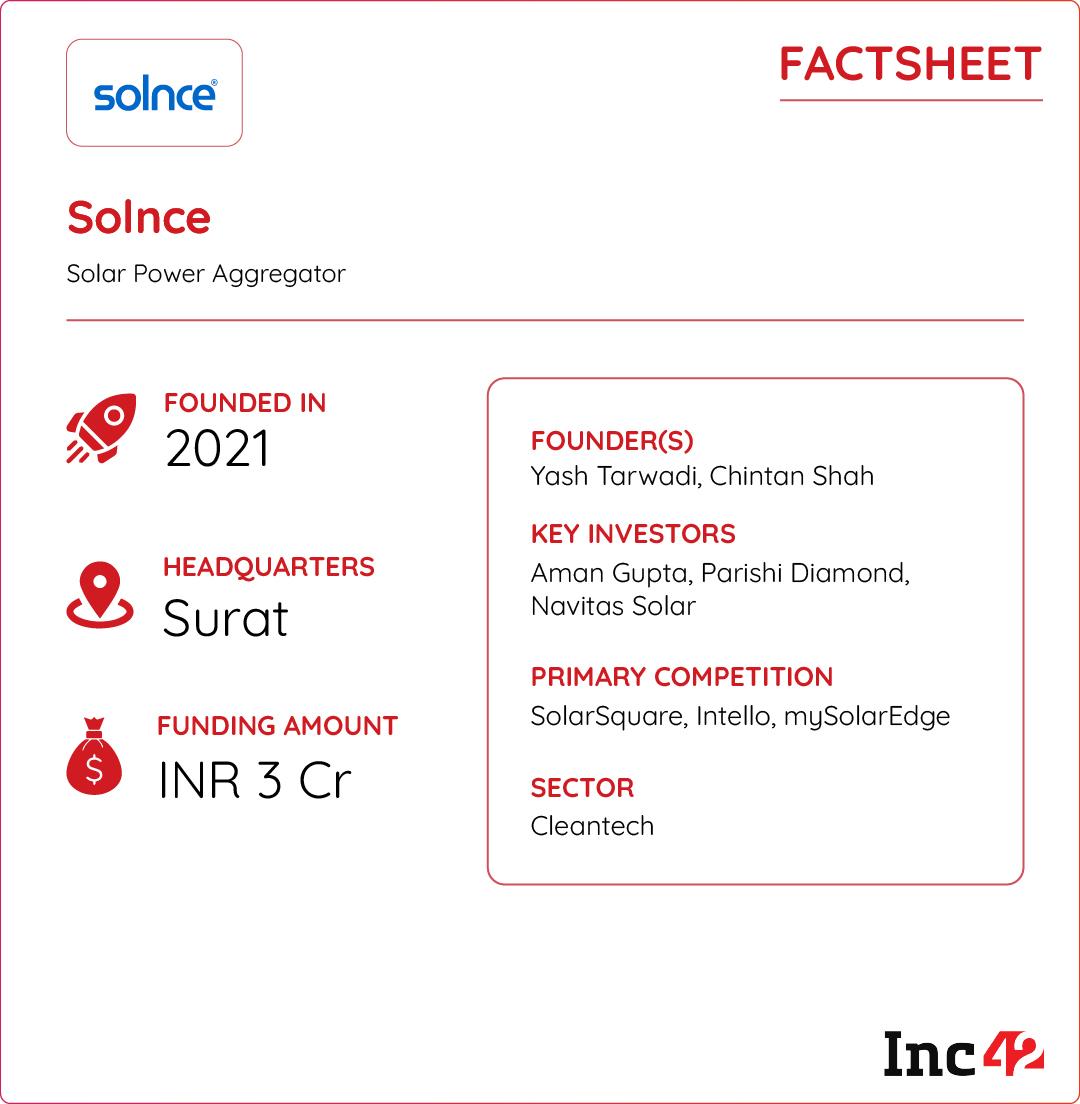In the 300 days of sunshine a year, a part of modern-day India endures a darkness that clouds its 300 GW solar power dream for 2030. Around the same time, the country aims to be a $5 Tn economy, pushing its decarbonisation drive harder.
Paradoxically, at the wheel for at least 30% of the Indian GDP, micro, small and medium businesses or MSMEs often find themselves locked in that solar darkness.
“MSMEs are facing the biggest challenge in solar adoption, despite their willingness to do so. This cannot continue. It is high time we found a solution,” Gujarat-based entrepreneur Yash Tarwadi told Inc42. He rolled out Solnce to bridge the gap between intent and action of solar installation.
The gap appears wider as MSMEs contribute 10-15% of total industrial emissions in India. Even though these businesses have been trying to adopt solar power to check their operational costs, the process of going green continues to be full of hurdles.
A SIDBI report recently pointed out that the green economy has significance in MSMEs beyond environmental considerations, such as reaching profitability through energy savings and enhancing market competitiveness.
In recent years, as part of its 2070 net-zero promises, India has taken big bets on cleantech – from solar to EV. Solar adoption has proliferated, helped by policy reforms, with the Centre claiming to have turned 50% of its installed capacity to non-fossil fuel sources by 2025 – five years ahead of its Paris Agreement deadline.
In step, the government has lined up financial incentives for MSMEs switching to solar power, such as a rooftop solar subsidy of up to 40% under the MNRE scheme for systems below 3 kW and 20% for systems between 3 kW and 10 kW.
Businesses, however, often find the policy support more robust for residential installations. These include the PM Surya Ghar: Muft Bijli Yojana, an initiative to boost domestic rooftop solar, and PM-KUSUM for solar-powered irrigation systems.
Despite the government initiatives, solar adoption faces multiple challenges – from broken supply chains and policy complications to cost and value concerns – not just for the MSMEs, but also for other industries.
“It isn’t that MSMEs are our only focus. In fact, we started off by catering to residential applications, as the problems are commonplace. But MSMEs are our main focus as the potential here is huge,” said Tarwadi, who has helped over 1,000 houses and entrepreneurs harness the power of the sun since 2021.
Solnce provides end-to-end service – from connecting customers with the engineering, procurement, and construction (EPC) service providers to post-installation maintenance.
“I didn’t want it to be part of a problem. I wanted to be part of a solution,” said the founder, as his startup competes with multiple local suppliers and stakeholders because of a decentralised ecosystem that’s both a challenge as well as a positive.

Pain Points Under The Sun
It didn’t take long for Tarwadi, then a fresh chemical engineering graduate, passionate about green power, to realise that solar as an area of business was highly scalable. His earliest project, a solar concentrator to convert seawater into potable water, received grants, but it highlighted that scaling it would need a huge capital infusion.
A deeper understanding of the market brought the problems to the fore. Pricing was the biggest hurdle, he felt, as he floated Solnce. There were multiple distributors of TATA’s solar panels in the market, quoting widely varying prices for the same products in the same city.
“Sometimes, the variations were as high as INR 3 Lakh in industrial installations, which would leave the customer confused as the awareness of the technology was in its nascent state,” he recounted. “We succeeded because of our transparent pricing.”
Then came the policy hurdles. One of Solnce’s early MSME customers failed to get the discom permission to install solar panels as it was involved in a disputed land case. Solnce took up the project and helped the company with a 20kW solar installation and helped it get the subsidy.
It was during this project that Tarwadi met Chintan Shah, who later joined Solnce as a cofounder. The duo has since doubled down on solar installations in both residential and industrial applications across 10 cities, including Surat, Ahmedabad, Lucknow and Rajkot. It has also made a direct presence in a few more cities through supply chains or through distribution channels.
Solnce claims that it delivers more value by keeping the installation process transparent. The way it has bridged customers with stakeholders involved in the process has helped build trust.
Alliance To Soak Up The SunThe unusual name with an apparently missing vowel is a union of two distinct words – sol, shortened from solar, and alliance, which tells its mission to create an order in a fractured market. Solnce is structured as an aggregator for solar power.
The cleantech startup runs two apps – one is customer-facing and the other is business-facing. The consumer app helps new users find out their eligibility amount for solar installation, which varies depending on the discoms, their electricity bills, and a few other factors. After these checks, the users can place their request for solar installation, which is then allotted to engineering, procurement and construction (EPC) companies.
Solnce takes care of all the financial, regulatory, and compliance procedures. Customers can track their power consumption on the app itself. It also provides a lifetime post-installation service and helps users track carbon credits and subsidies.
On the business app, EPC contractors and distributors can place their bids for upcoming projects and get the contracts.
The startup is also building solar parks for MSMEs. These are large chunks of land developed with common facilities like transmission infrastructure, road, water, drainage and communication network, with all statutory clearances. This solves the problem of space crunch for the MSMEs and saves installation costs. Solnce today serves at least 100 MSMEs across manufacturing, textile, diamond, chemical, pharma, cement and building material industries in a highly competitive market.
Its top clients include Gulmohar Embroideries, Spencer Weavetech, SA Diamonds, Vidya Bharti School, and new Jilla Panchayat Bhavan at Surat.
A Sunlit Harvest Of SuccessSolnce has built an asset-light business with a sharp focus on staying profitable from day one. “For me, RoI is the key. Building a loss-making business is not even a choice,” Tarwadi noted.
Fixed firmly on the return on investment, Solnce has so far raised only INR 3 Cr from the likes of BoAt founder Aman Gupta (from Shark Tank India earlier this year), Parishi Diamond’s investment arm, Navitas Solar, and some angels.
The company follows a simple aggregator method for revenue generation. It keeps around 90% of the total project cost, while 6-10% of the rest goes to the EPC solution providers. The solar parks catering to the MSMEs make up over 60% of its revenue, while residential applications constitute 10%. The rest comes from individual industrial installations.
In FY25, the company generated INR 40 Cr in revenue, which was more than a 100% on-year growth from INR 19 Cr. Tarwadi said the business generated around INR 3 Cr in profit in the year ended March 2025, as against INR 27 Lakh a year ago.
On the contrary, its closest rival SolarSquare crossed INR 100 Cr in FY23 revenue, yet continued to be a loss-making entity. SolarSquare has raised more than $60 Mn in funding since its inception in 2015, which is huge compared to Solnce’s total funding.
“Our focus on being an MSME-first business and an asset-light model has helped us keep costs low and be profitable early on in our journey,” said the founder.
Along the road ahead, Solnce plans to explore another source of revenue by leveraging the scope of carbon credits. These are calculated from the reduction or removal of carbon emissions. It is measured in tonnes of carbon dioxide equivalent that an organisation removes from the environment. Companies with higher emissions can purchase carbon credits to offset their own emissions.
Solnce is tying up with registries that allow the transaction in carbon credits. Though in its infancy in India, carbon credits are fast gathering significance as countries double down on their emission reductions. By enabling and allowing its customers to transact these carbon credits through the Solnce app, the startup plans to cut a certain percentage of them to generate revenue.
Chasing The Sun, Powering Solar FutureAlong the course of its Vision 2030, India has achieved a cumulative installed capacity of nearly 106 GW out of its nearly 300 GW of solar power target. This ambitious target unfurls a huge market opportunity for companies like Solnce that are structured to help businesses negotiate various hurdles that slow down the pace of adoption.
But who will steer the growth? It is the small businesses that are coming in a big way, making up nearly a third of the world’s fourth-largest economy, according to the Solnce founder.
India is home to more than 6 Cr registered MSMEs, creating jobs for more than 110 Mn people, but most of them are shelling out 5-10% or 10-20% of their operating income on electricity. “This augurs a great opportunity in a developing market like India. Rooftop solar power can help MSMEs build margins,” Tarwadi said.
Residential adoption, too, is picking up pace, making Solnce’s growth outlook more bullish.
The startup is betting big on its expansion and solar park projects, and anticipates a lower on-year growth in profit because of marketing expenses it will incur this year. The startup aims at an INR 100 Cr revenue on a profit of around INR 6 Cr for FY26.
Solnce plans to onboard around 5,000 customers in the next two years and focus more on residential adoption to beef up the numbers, while industrial installations will continue to drive volumes and revenues.
“But,” said the Solnce chief executive, “We need more conducive policies from the government to drive it to its net-zero goal by 2070. Without the source being green, the exercise of the EV push is also futile to a great extent.”
The question remains: When will the MSMEs come out of the solar darkness in India?
[Edited By Kumar Chatterjee]
The post Can Solnce Spark A Solar Power Revolution Among Indian MSMEs? appeared first on Inc42 Media.
You may also like

DIY flight turs fatal: 88-year-old Russian inventor killed in self built helicopter; blades detach during takeoff

Animals as Leaders forced to cancel concerts as drummer suffers 'serious injury'

Sarah Ferguson plans start selling 'eco-nappies' in brand new career move

James Whale has 'found peace' over the prospect of dying thanks to amazing palliative care

Nutrica by BN Group forays into the honey category with function-first Nutrica Bee Honey







